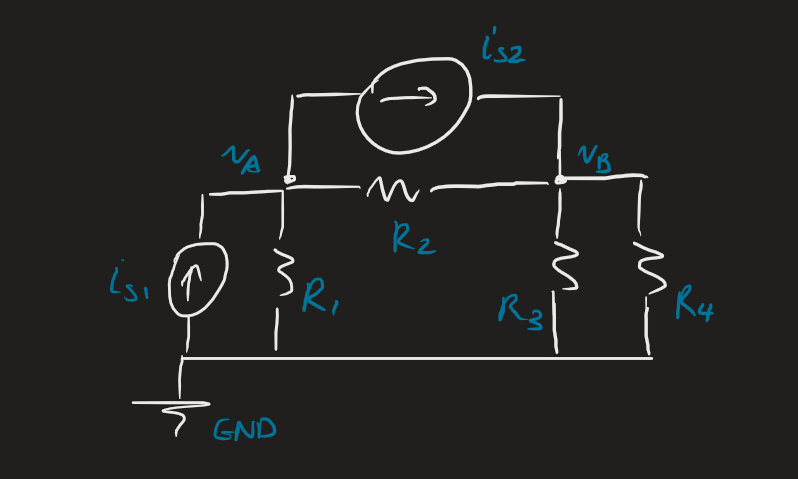Nodal analysis is a method used to solve linear circuits. We use KCL, assuming current going in is equal to current out. You should have a total of linearly independent equations, alternatively .
Some tips:
- For the branch with only a voltage source not connected to the ground, set it as a supernode.
- Always select some ground node. It’s easiest if the node with the largest number of branches connected to it is chosen since it will simplify our linear equations. The ground at one end of a voltage source is a good idea.
- Please do not set more nodes than actually exist. If the only connection between two nodes is a wire, then they are the same node.
The setup
Our basic KCL term for a node is as follows:
We adopt an unambiguous method for nodal analysis.
- Set some ground node.
- Assume resistor polarity if not given. Set some positive and negative terminal for resistors, where current goes from positive to negative.
- Label each node of interest.
- Write KCL equations. We use the basic term below, but always use the assumed positive voltage minus negative voltage over resistance.
- Current going in is on the left side, current going out is on the right side.
For circuits with voltage sources, our basic term doesn’t work. If one end of the source is connected to ground, then since , then one term is 0 and we can easily solve for for one of the nodes. This means one less equation to solve. If the source is not grounded, then we don’t write a KCL equation for that node.
If both ends aren’t connected to the ground, then we can use a supernode, and write an additional equation for the voltage source .
For controlled sources, we simply incorporate their constraints.
By inspection
In our equations, we usually have to split terms up to row reduce. A nice set of rules is:
- Add the conductances connected to the node in question.
- For an adjacent node, subtract the conductance times the voltage of that node.
For example:
 Our equations are:
Our equations are:
Addendums
An equally valid approach, which I always learned is as follows:
- We don’t assume some resistor polarity ahead of time.
- Set some ground node to simplify KCL equations.
- We label each node of interest as some respective voltage, i.e., .
- We then write our KCL equations. At some node, we always write as: node we’re looking at minus other node across resistor divided by resistance.
- All current going out is negative, all current going in is positive. Sum and set to 0.